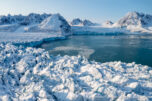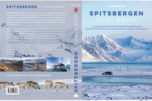-
current
recommendations- Liefdefjord
New page dedicated to one of Spitsbergen's most beautiful fjords. Background information and many photos.
- New Spitsbergen guidebook
The new edition of my Spitsbergen guidebook is out and available now!
- Liefdefjord
New page dedicated to one of Spitsbergen's most beautiful fjords. Background information and many photos.
Page Structure
-
Spitsbergen-News
- Select Month
- May 2025
- April 2025
- March 2025
- February 2025
- January 2025
- December 2024
- November 2024
- October 2024
- September 2024
- August 2024
- July 2024
- June 2024
- May 2024
- April 2024
- March 2024
- February 2024
- January 2024
- December 2023
- November 2023
- October 2023
- September 2023
- August 2023
- July 2023
- June 2023
- May 2023
- April 2023
- March 2023
- February 2023
- January 2023
- December 2022
- November 2022
- October 2022
- September 2022
- August 2022
- July 2022
- June 2022
- May 2022
- April 2022
- March 2022
- February 2022
- January 2022
- December 2021
- November 2021
- October 2021
- September 2021
- August 2021
- July 2021
- June 2021
- May 2021
- April 2021
- March 2021
- February 2021
- January 2021
- December 2020
- November 2020
- October 2020
- September 2020
- August 2020
- July 2020
- June 2020
- May 2020
- April 2020
- March 2020
- February 2020
- January 2020
- December 2019
- November 2019
- October 2019
- September 2019
- August 2019
- July 2019
- June 2019
- May 2019
- April 2019
- March 2019
- February 2019
- January 2019
- December 2018
- November 2018
- October 2018
- September 2018
- August 2018
- July 2018
- June 2018
- May 2018
- April 2018
- March 2018
- February 2018
- January 2018
- December 2017
- November 2017
- October 2017
- September 2017
- August 2017
- July 2017
- June 2017
- May 2017
- April 2017
- March 2017
- February 2017
- January 2017
- December 2016
- November 2016
- October 2016
- September 2016
- August 2016
- July 2016
- June 2016
- May 2016
- April 2016
- March 2016
- February 2016
- January 2016
- December 2015
- November 2015
- October 2015
- September 2015
- August 2015
- July 2015
- June 2015
- May 2015
- April 2015
- March 2015
- February 2015
- January 2015
- December 2014
- November 2014
- October 2014
- September 2014
- August 2014
- July 2014
- June 2014
- May 2014
- April 2014
- March 2014
- February 2014
- January 2014
- December 2013
- November 2013
- October 2013
- September 2013
- August 2013
- July 2013
- June 2013
- May 2013
- April 2013
- March 2013
- February 2013
- January 2013
- December 2012
- November 2012
- October 2012
- September 2012
- August 2012
- July 2012
- June 2012
- May 2012
- April 2012
- March 2012
- February 2012
- January 2012
- December 2011
- November 2011
- October 2011
- September 2011
- August 2011
- May 2011
- April 2011
- March 2011
- February 2011
- January 2011
- December 2010
- November 2010
- September 2010
- August 2010
- July 2010
- June 2010
- May 2010
- April 2010
- March 2010
- February 2010
- November 2009
- October 2009
- August 2009
- July 2009
- June 2009
- May 2009
- April 2009
- March 2009
- February 2009
- January 2009
- December 2008
- November 2008
- October 2008
- August 2008
- July 2008
- June 2008
- May 2008
- April 2008
- March 2008
- February 2008
- April 2000
- Select Month
-
weather information
-
Newsletter

| Guidebook: Spitsbergen-Svalbard |
Home →
Yearly Archives: 2019 − Travelblog
Spitsbergen back to winter mode on Easter Sunday
After an early snow melting period last week, the winter returned to Spitsbergen exactly on Easter Sunday with temperatures below zero. After a couple of very wet and grey days, which frustrated tourists, locals, guides and tour operators alike, molten snow became ice – at least! – and the sun came out again.

Longyearbyen Camping: last week a lake, this week an ice area.
Longyearbyen Camping, last week an impressive landscape of lakes and lagoons, is now an ice area, with a surface just a bit too rough to provide a useful skating rink. Elsewhere, it is flat and shining as a mirror, something that does not make moving around easier, both in the field and in town. Spikes (isbrodder in Norwegian) can be very helpful and may prevent accidents.
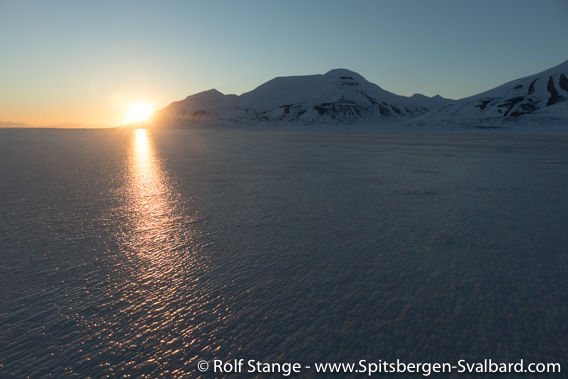
Adventdalen: last week a river, this week a skating rink.
Now it is good to be outside again!
And, yes: the Easter bunny also came all the way north to Spitsbergen. Happy Easter! 🙂
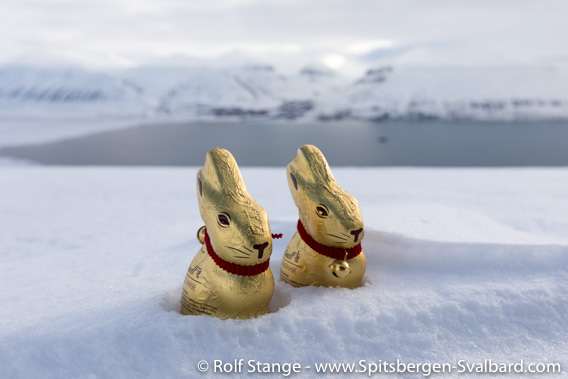
Happy Easter!
The ice cave in Longyearbreen
Snow melt – 4 weeks too early
Currently – today it is 18 April – I get the impression that Spitsbergen is really melting and flowing away. The snow melt has started, several weeks to early. This April will without any doubt be the 101st month in a row with temperatures above the long-term average.
But more about that later. One effect of the weather is that I have some time to write again now. It has been a while ago …
Ice cave – 4 weeks ago
… that we went to the ice cave in Longyearbreen. There are ice caves here in pretty much all glaciers, and the one close to Longyearbyen are popular places to visit, both by tourists with guides and by locals. You can dog-sledge or ski to the ice cave in Scott Turnerbreen in Bolterdalen, you can hike to the one on Larsbreen, also with snowshoes or on ski, and you can get to the one on Longyearbreen with a wider range of transportation means, here also including snow mobile or snow cat.

In the ice cave in Longyearbreen (mid March).
The ice caves are actually meltwater channels, but they usually fall dry during the winter season (meltwater flow may occur at any time of year, so be careful). Then they can be visited. Depending on the “terrain”, this can be easy or difficult. Some are so narrow and steep that visiting them may be impossible, at least for normal people, others are more visitor-friendly. In any case, an ice cave is a fascinating experience!
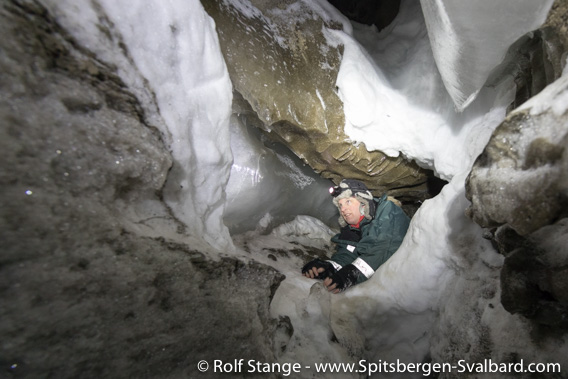
Ice cave in Longyearbreen.
Usually I don’t post too many pictures of myself, but I do like this one 🙂
Mohnbukta: snow mobile tour to Spitsbergen’s east coast
Tue
2 Apr
2019
As beautiful as Longyearbyen’s surroundings are especially at this time of year, it is always tempting and actually also great to get further away from “civilisation”. We take the opportunity that the fine weather provides, pack the sledges and set course east through Adventdalen. Spitsbergen’s east coast, especially Mohnbukta, is a classical destination for snow mobile tours in the late winter – now – for good reason, as you will see!
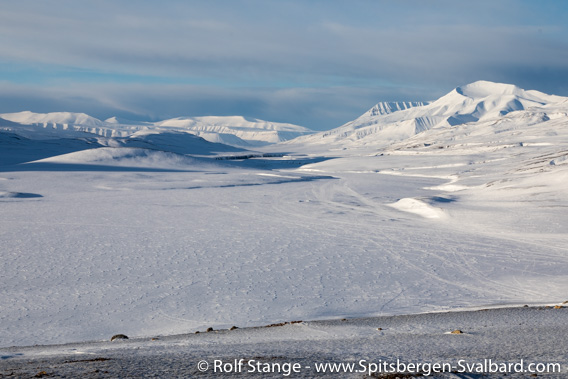
View over inner Adventdalen.
It is cold, around minus 20 degrees centigrade as so often during the last couple of weeks. Clear and calm.
The large moraine of Rabotbreen, east of Sassendalen, may be an obstacle for some who are not used to driving snow mobiles, as there are some curves, bends and little slopes.
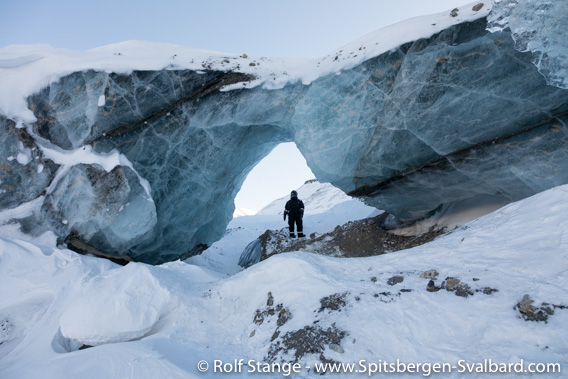
Dead glacier ice in the moraine of Rabotbreen.
For us, it is a great and very impressive bit of landscape. Just the scale is enormous! And then there are some exposed bits of dead glacier ice, slowly melting away, creating some amazing shapes and colours on their way back to the global water cycle.
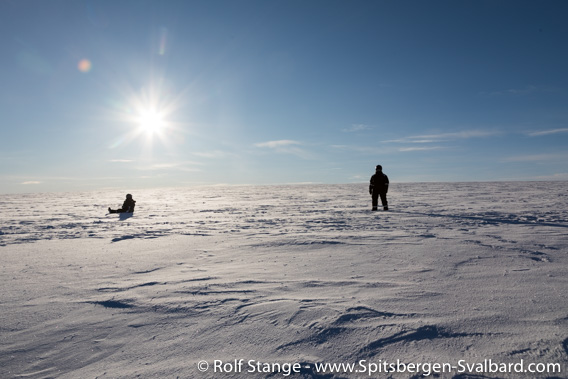
The little ice cap Nordmannsfonna.
We continue across Nordmannsfonna, a little ice cap where you get a litte impression of how it might be in central parts of Greenland or Antarctica. It is of course just a miniature version of those continental inland ice masses, but for me this is enough. Honestly, I have never really been keen on going to any pole, by burning nuclear fuel to get to the north pole or by burning endless volumes of aircraft fuel to get to the south pole, where tourists are not always really given a warm welcome by the crew of the Amundsen-Scott South Pole Station. But anyway … I am getting off topic. I am happy here on Spitsbergen’s Nordmannsfonna and her relatives around here 🙂

Weathered iceberg in Mohnbukta.
We have reached Mohnbukta after a short drive down another glacier. The bay and the wide waters of Storfjord are frozen solid as far as we can see, and we have a fantastic view all the way to Barentsøya and Edgeøya. The ice is a fantastic world in itself! There are some small (well, it is all relative), but beautifully (absolutely!) weathered icebergs frozen in the sea ice. We had some stunning specimens here in earlier years, click here for some panorama photos of ’em.
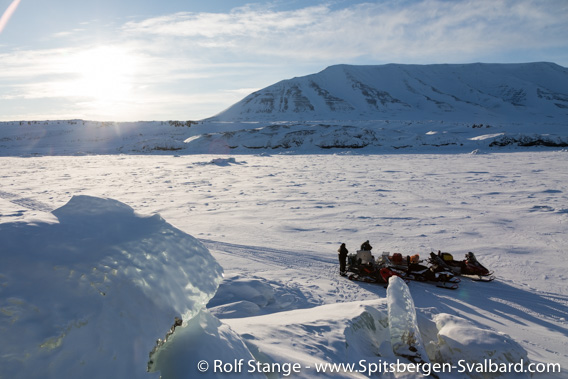
Lunch break in Mohnbukta.
A great place for a little lunch break 🙂
Then there is the glacier front of Hayesbreen as the scenic highlight of the day. Just stunning! Especially on a day like this. Now – it is late March – the sun is still low even around noon, which is when she is coming from the perfect direction to illuminate this amazing ice cliff. A great spectacle of ice, of colours, shapes and size!
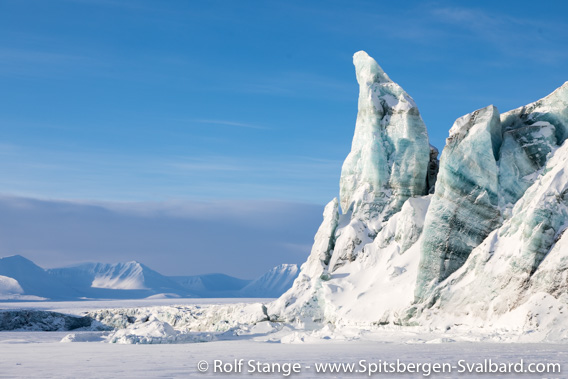
Glacier front of Hayesbreen, Mohnbukta (I).
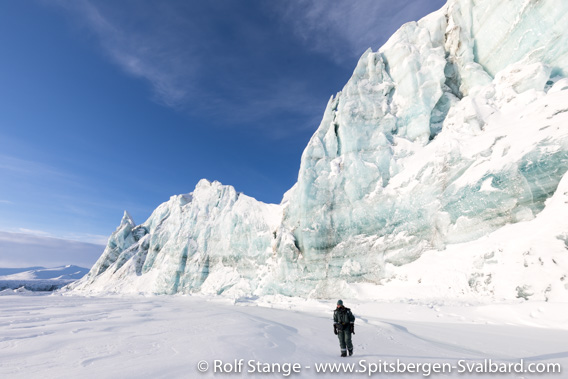
Glacier front of Hayesbreen, Mohnbukta (II).
Then … off again, and back home. We have still got more than 90 kilometres ahead of us.

Way back home over Königsbergbreen.
The lovely evening light makes the trip over Königsbergbreen and through Sassendalen another delight. Something we just have to enjoy, there won’t be any evening light here anymore in just a few weeks time!
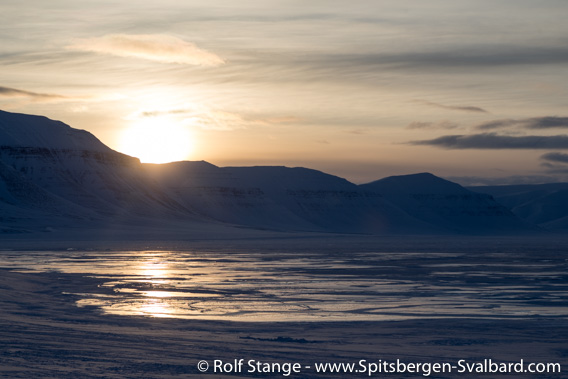
Evening light in Sassendalen.
Finally, my current ceterum censeo: I have made a new photo book, focussing on aerial photography and thus showing the Arctic from a very unsual perspective. In theory, the book is in German, but in practice, it does hardly have text. 134 out of 137 pages do just have stunning photos, placenames and a little map. Norwegens arktischer Norden (2) – Aerial Arctic shows Jan Mayen and Svalbard from the air.
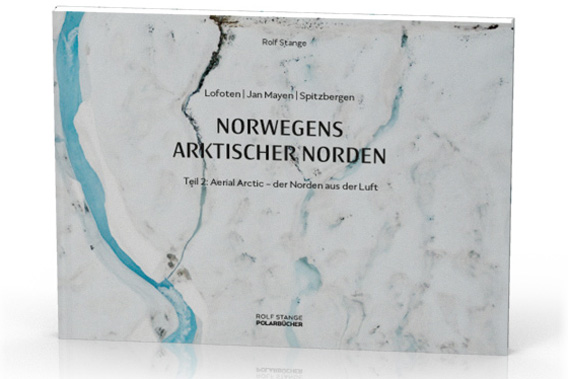
Rolf’s new photo book Norwegens arktischer Norden (2) – Aerial Arctic shows Jan Mayen and Spitsbergen from a new and stunning perspective.
Northern light …
Sun
24 Mar
2019
The days are getting longer, and time is just flying! Now we have already had this year’s spring equinox. The equatorial plane of the Earth passed through the centre of the sun on Wednesday (20 March) at 21.58 hours (UT = universal time = GMT). From now on, the days are longer again than the nights on the northern hemisphere, and the further north you are, the more light and the less darkness.
This means that the current northern light season in Spitsbergen is now slowly coming to an end. On Saturday (16 March) we had another amazing celestial performance. A stunning aurora borealis, intense, vibrant, fast.
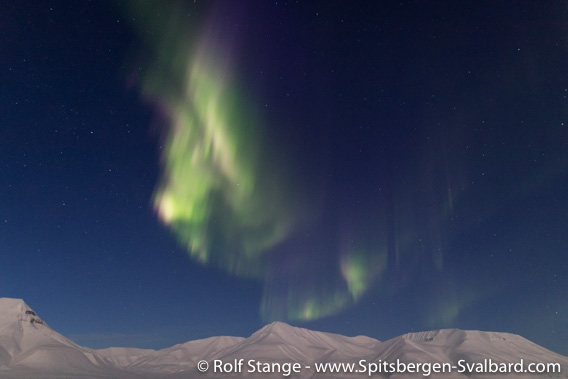
Auroa boralis above Operafjellet.
The northern light season in Spitsbergen is now coming to an end.
This northern light was definitely above average! To capture the very fast movement, I used shutter times of up (or, rather, down) to 0.3 seconds, and even that was probably too slow to capture the filigrane, but very lively structures (click here to read more about northern lights and how to photograph them).

Aureole (or dome) of northern light above Adventdalen.
The last days were full, there was just no time to write new blog entries … there will be more soon.
Solfest: Sola er tilbake – the sun is back!
Tue
12 Mar
2019
Sola e’ tilbake! That was the motto of the day last Friday (several day ago already, time is running!), which was THE big day: solfest – sun fest – in Longyearbyen!
As mentioned, the sun has actually returned to the lower part of Longyearbyen, near Adventfjord, several days before …
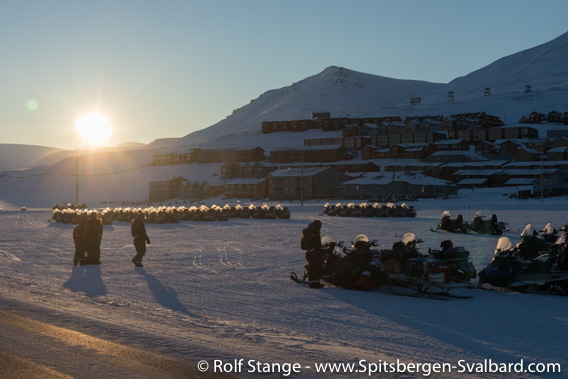
Sun in lower Longyearbyen, Friday (8.3.) morning.
… but as those parts of Longyearbyen did not exist back then, the solfest is traditionally and duly celebrated on 08 March, shortly after 12.30 hours, as the sun returns to the stairs of the old hospital. This old hospital building is long gone, but the stairs from the back door are still there. Actually, the stairs are said to be a reconstruction so people know where to celebrate, but anyway … they are next to the kindergarten close to the Svalbard church. So that is where everybody meets on solfest-day at 12.30 hours. Hundreds of people gather to welcome and celebrate the sun! Especially the children, dressed as little suns, really sweet. Everybody is singing and cheering the sun up, who is doing her best to climb above the mountain: Sol! Sol! Komm igjen! Sola er min beste venn! – Sun! Sun! Come on! The sun is my best friend! The rhyme does not really work in English, well.
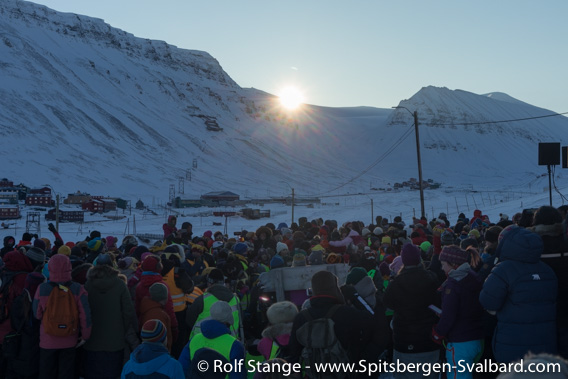
Sunrise above Lars Hiertafjellet during the solfest in Longyearbyen,
Friday noon (8.3.).
And finally, here she is! The sun, bright as ever, climbs over the rim of Lars Hiertafellet, behind Larsbreen, and there is great cheering and jubilation. It is really an emotional moment! There has not been any direct sunlight in Longyearbyen during 5 months, due to the mountains around the settlement.

Sunny view towards Gipshuken and Billefjord.
Yes, the sun is back. It is great to be outside, to enjoy the light-flooded landscape and to feel the sun on the skin.
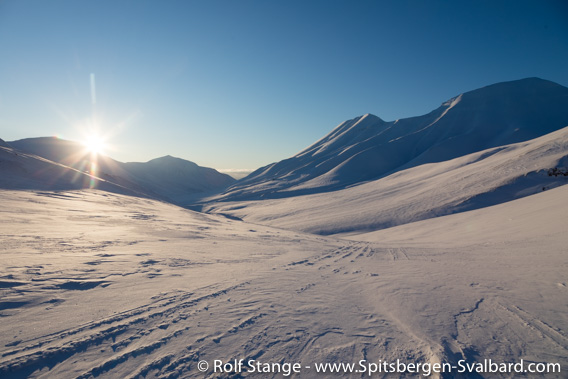
Sun over Nordenskiöld Land.
But, it is and remains icy cold, the thermometer is rather constantly somewhere near minus 20 degrees centigrade. There is fresh ice near the shore of Adventfjord, but a solid ice cover just does not want to form in spite of the cold. The warm water supply coming with the West Spitsbergen Current (“Gulf Stream”) is inexhaustible, I guess. Unfortunately. A frozen Adventfjord, that would be great. We have not had that for quite a few years.
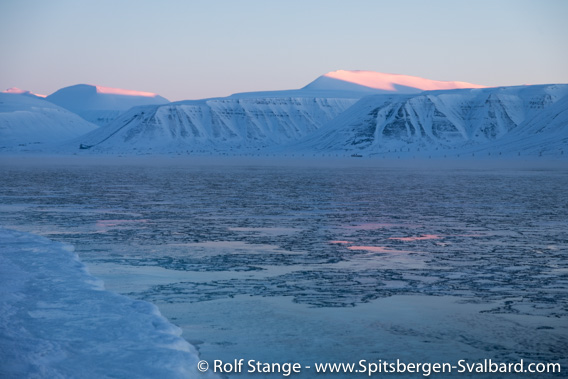
Fresh ice forming near the shore of Adventfjord, in Hiorthhamn.
Sassendalen and Tempelfjord
Sat
9 Mar
2019
The winter keeps showing off with cold, stable weather and the sun is climbing a tiny little bit higher every day. We make use of such grand conditions as often as possible to enjoy the outdoors in this amazing country, to which the light is now returning with might.

Sassendalen.
Here, we are in Sassendalen. It is big and wide, one of Spitsbergen’s largest valleys. At this time of year, it is one of the most frequently used snow mobile routes, to the east coast or to Tempelfjord. But it is so big that it is easy to find a silent corner without traffic.
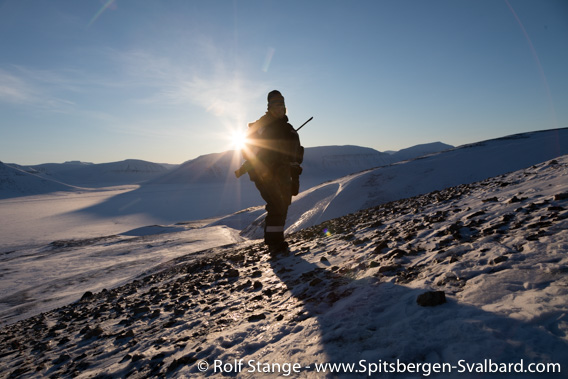
Hiking in Sassendalen.
We park our snow mobiles in such a silent corner and start hiking up a gentle, but endless slope. You could hike a whole, long day here without really getting somewhere, but getting somewhere is not the point here. Just being here is the point. It seems a bit otherworldly. The light, the landscape … the wind has blown the snow away from many surfaces. The country appears very barren. Nevertheless, many reindeer roam here, trying to find some food.
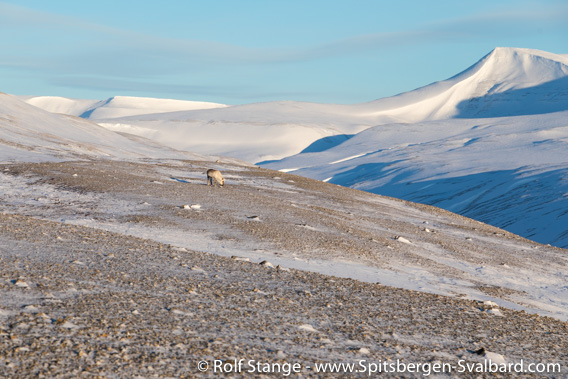
Reindeer in polar-desert-like landscape, looking for food.
Later, we drive north, towards Tempelfjord. We have been here some weeks ago already. Today, the landscape shines in completely different light, the intensity of which is impossible to grasp with a few words unless you are Sheakespeare.
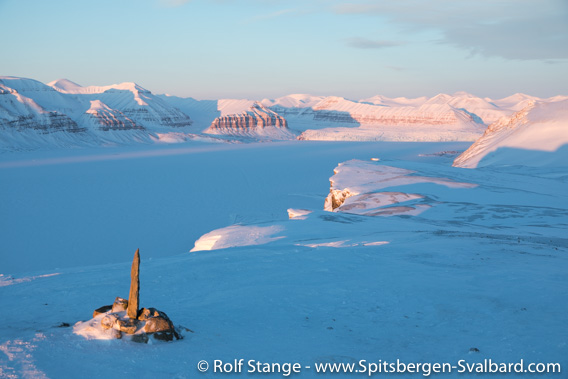
View from the mountain Fjordnibba into Tempelfjord.
Even under “normal” light conditions, the view from the little mountain Fjordnibba over Sassenfjord and Tempelfjord is stunningly beautiful. Whoever created this landscape must have been in excellent mood that day. Amazing.
And then in this light …
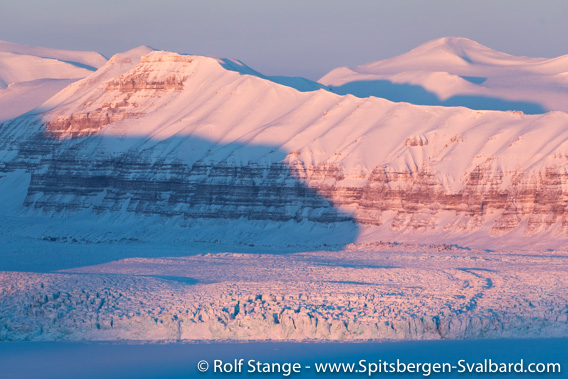
Glacier front of Tunabreen in Tempelfjord in sunset light.
>
You just can’t spend enough time in such places! I just have to return as often as I can.
And the timing is just perfect right now. It is just before 4 p.m., the sun is about to disappear behind the mountains, casting the last direct light of day in fire-red colour over mountains, fjords and glaciers.
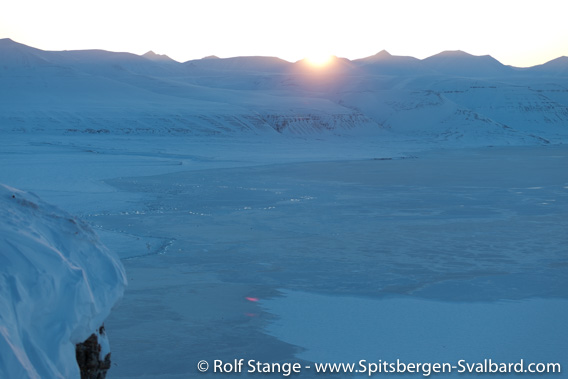
Sunset over Sassenfjord and Nordenskiöld Land.
Inner Tempelfjord is largely frozen solid – only at Fredheim, the ice has broken up recently – and now there is a fresh ice cover forming also further out in Sassenfjord. Let’s see how far far the development goes this season. Here, we have the view towards Diabasodden in outer Sassenfjord.
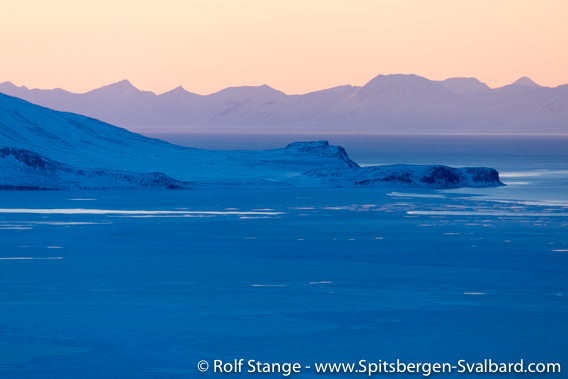
View from Fjordnibba to Sassenfjord and Diabasodden.
A final little excursion takes us from the mountain down to sea level at Fredheim. It is icy cold today, air temperatures are around -25 degrees centigrade. The cold becomes visible in the colours, which range from pink through purple to blue. Colours of frost and ice.

Ice on the shore in Tempelfjord at Fredheim.
Finally, a last view into Tempelfjord. As I said, colours of the cold! A picture can give you an idea of the colours – just an idea, but at least – but it does not deliver the sounds. The silence is one thing, the sound of the ice yet another. The ice is constantly working on the shore, being moved by the tides and possibly by some waves further out, in open water. The ice is groaning and moaning, squeaking and squealing. Not load, but constantly.
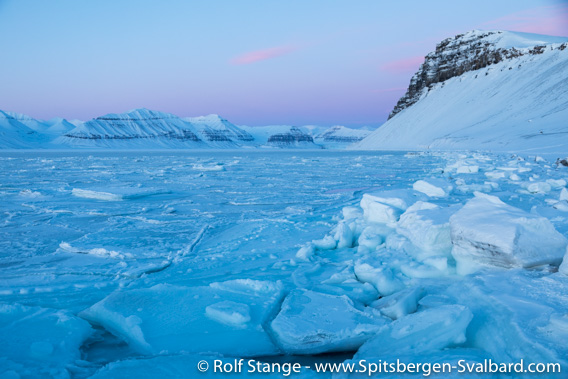
Ice on the shore of Tempelfjord at Fredheim.
Finally, my current ceterum censeo: I have made a new photo book, focussing on aerial photography and thus showing the Arctic from a very unsual perspective. In theory, the book is in German, but in practice, it does hardly have text. 134 out of 137 pages do just have stunning photos, placenames and a little map.
Norwegens arktischer Norden (2) – Aerial Arctic shows Jan Mayen and Svalbard from the air.

Rolf’s new photo book Norwegens arktischer Norden (2) – Aerial Arctic shows Jan Mayen and Spitsbergen from a new and stunning perspective.
Sun festival in Longyearbyen
Wed
6 Mar
2019
Spitsbergen was under full control of the polar night just a few weeks ago, but now the light is returning with full force. The sun is getting higher up on the sky every day, and around mid-day, the mighty Hiorthfjellet is already fully exposed to the sun.
The return of the sun is celebrated for one week in Longyearbyen with the traditional “Solfestuke” (sun festival week) with a range of events. The first one was a firework on the night sky 🙂
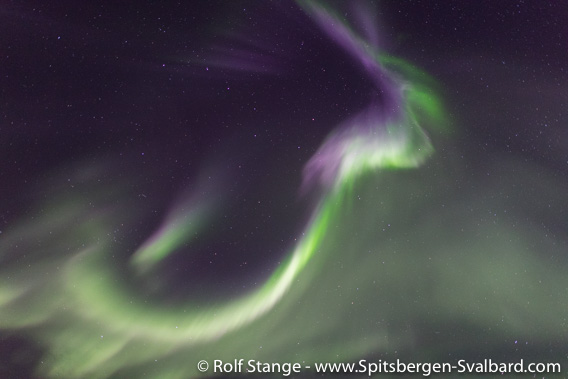
Northern light in Adventdalen.
The sun, herself obviously not visible, had clearly in pretty good mood, letting off steam towards us out here in space. The whole spectacle lasted for a while, so we could change posotion and perspective.
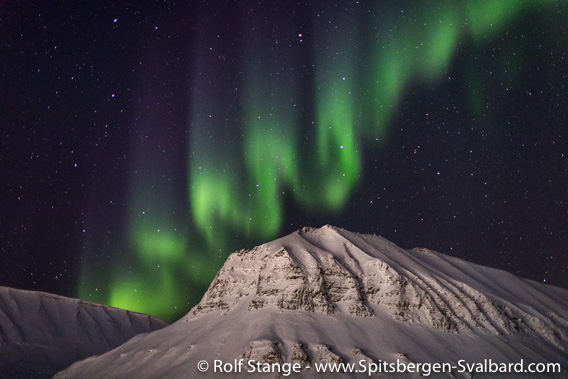
Northern light above Sarkofagen south of Longyearbyen.
The “Spitsbergenrevye” is the traditional opener of the Solfestuke. The revye brings events and people on the scene of old Huset in Longyearbyen which have moved people here in one or another way in the year that has passed. Satire, humour and music are definitely part of the event. Good fun, especially if you understand Norwegian with a northern colouration and you have done your homework and followed Svalbardposten (or this blog!).

Spitsbergenrevye in Huset. Sun festival week, Longyearbyen.
Polar bears and coal mining are always part of the show.
Another traditional part of the Sun festival week is a church service – outdoors at Telelinken on the slope of Hiorthfjellet, where you see the sun earlier than in Longyearbyen. Weather permitting, that is. And it was clear and sunny! But cold … below -20 degrees centigrade, and windy. Cold.
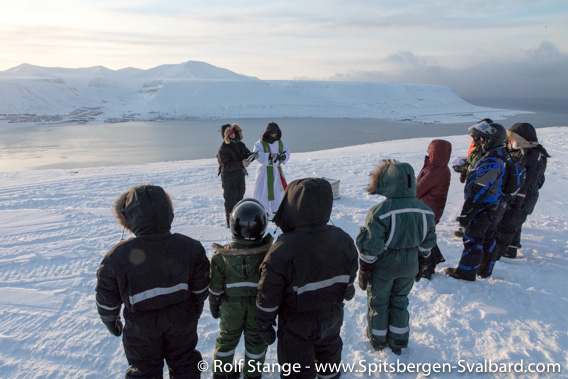
Open air church service at Telelinken (I). Sun festival week, Longyearbyen.
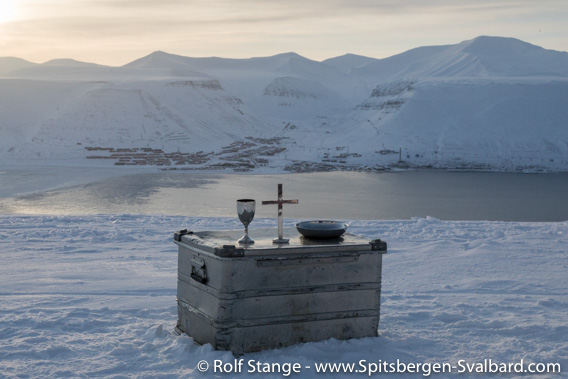
Open air church service at Telelinken (I). Sun festival week, Longyearbyen.
In Longyearbyen, the sun will shine “officially” again on 08 March. Practically, it is actually a bit earlier as you can see on the next photo.
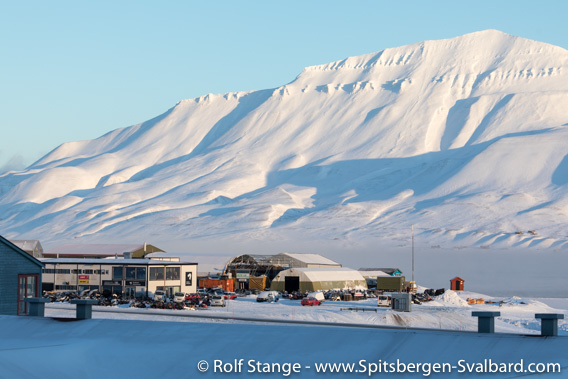
Svalbard Snøskuterutleie in the sun – on 05 March.
The sun was shining on Svalbard Snøskuterutleie, lowermost in Longyearbyen near Adventfjord and Adventdalen, on Tuesday, 05 March!
Nevertheless, 08 March is the correct date for historical/traditional reasons (unless it is a leap year). The lowermost part of Longyearbyen, where the sun is shining a few days earlier, did not exist back then. As soon as the sun is seen from in Skjæringa, the oldest part of Longyearbyen where amongst others Svalbard Kirke (the church) is located, it is time to celebrate – that will be on Friday!
February-impressions from Spitsbergen
Sat
2 Mar
2019
February can be a beautiful month in Spitsbergen. Especially if it is nice and cold and not as battered by climate change as last year, when warm air incursions brought several periods of thawing and rain. This year, we have had good frost for most of the time in February. Cold, clear weather and not too much wind. The sun is still largely behind the horizon and hidden by mountains, but the mountain tops started glowing a good week ago and we have had the first rays of sunshine on our frozen noses! You still have to do a little trip to enjoy that pleasure, the sun won’t reach Longyearbyen before 08 March.
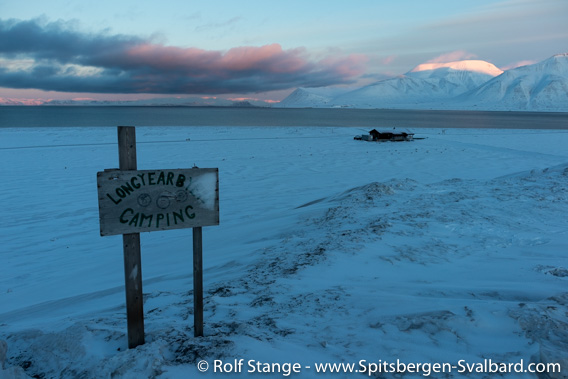
Longyearbyen Camping is still a quiet place.
The average temperature in February was -11.1°C, “only” 5.1 degrees above the long-term average which is defined as the average from 1961-1990. Five degrees above a “normal” temperature that is impossible to reach now! That is still a lot. Nevertheless, a monthly average of -11.1°C involves a lot of fine frost. Even the fjord, Adventfjord, seems to consider freezing over again, just for a change. This has not happened in many years. It is unlikely to happen this year either, but there is at least some initial ice formation in protected in-shore corners.
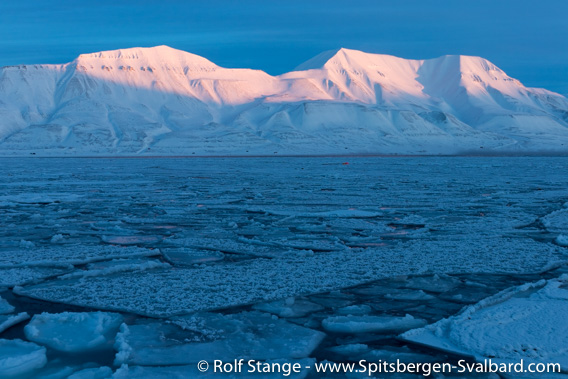
Ice in Adventfjord and sun on Hiorthfjellet and Adventtoppen.
You still have to make sure you get out around mid-day to catch some direct sunrays. An afternoon trip does not bring anything but twilight. Which can of course also be beautiful, but if you want the see the sun, then this is not the real thing.
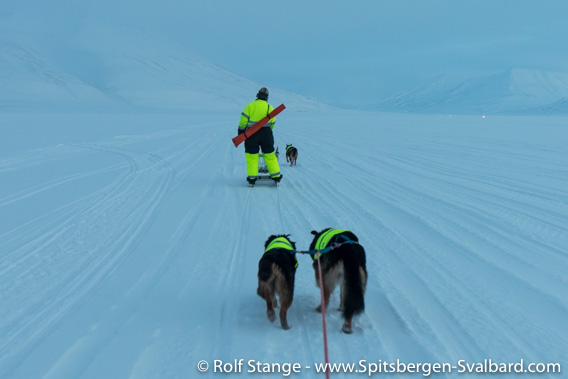
Out with ski and dogs: “rope skiing” (snørekjøring) in Adventdalen.
Hiorthfjellet, the characteristic mountain opposite of Longyearbyen, is a very popular place these days. Half-way up the slope, there is a hut with some large antennas, which is locally known as Telelinken. Perfectly placed on a slope facing south with a fantastic view over Adventfjord and a good place to catch some first sunrays!
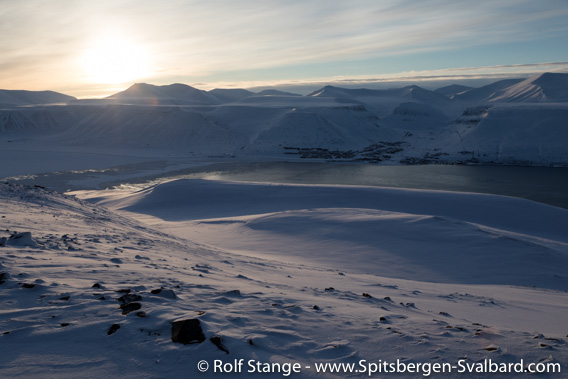
First sun over Adventfjord.
The air temperature is minus 20 degrees centigrade, but we enjoy the first direct sunrays on those few square centimetres of exposed skin that we have had for some time …
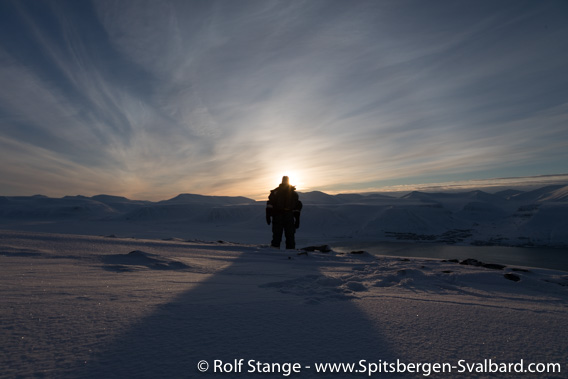
Arctic sun worshipper.
… and the amazing light that the low sun brings back to this cold island.
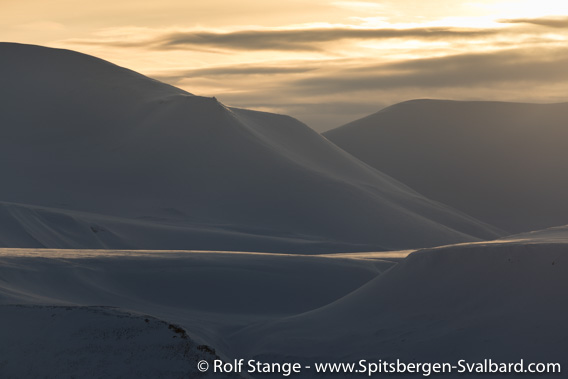
Sunny views of some mountain tops in Nordenskiöld Land.
There is not yet much wildlife beyond those species that spend the winter here, arctic fox and reindeer. Recently, still in dark time, there was a common eider near the shore in Longyearbyen. That one has probably spent the winter in Adventfjord, something that is not common but not unheard of either. A kittywake has been seen some days ago.
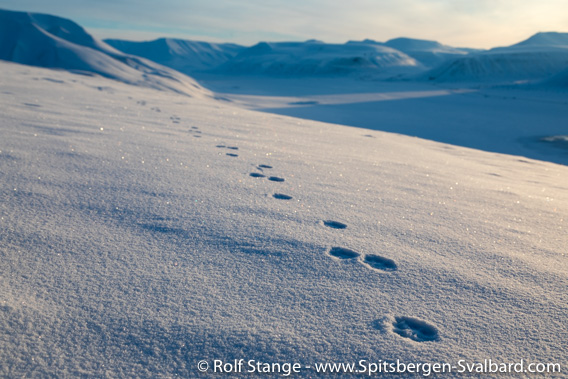
Tracks of an arctic fox on Hiorthfjellet.
Arctic winter light in Tempelfjord
Thu
21 Feb
2019
Some visit a temple to find enlightenment.
We visit Tempelfjord and find the light.
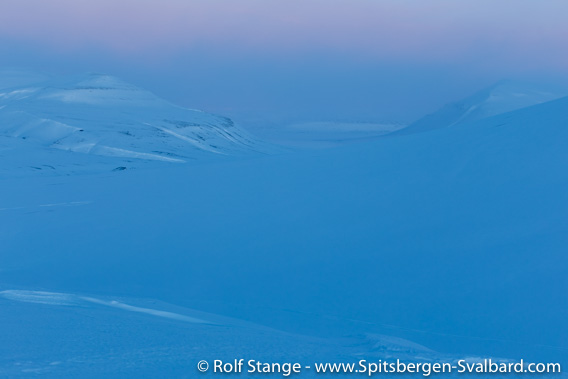
View through Eskerdalen, Sassendalen in the distance
in the dawn of the early polar day in February.
The start of our little excursion was admittedly a bit bumpy. First we had to drag a car out of a deep snow hole that a supposed turning around area had turned out to be. It was not the first time that f§/%!”=g hole has fooled someone. We should put up a sign …

View over outer Tempelfjord towards Isfjord.
Also the snow mobiles don’t want to do what we want them to do, something these things quite often do. But finally we are off and on the road. It is a bit fresh today, well below -20°C around Longyearbyen and certainly not far from -30 in Sassendalen and Tempelfjord. A colleage who was on the east coast today said later that he estimated the air temperature on the glaciers around -40°C … as mentioned, it is fresh today.
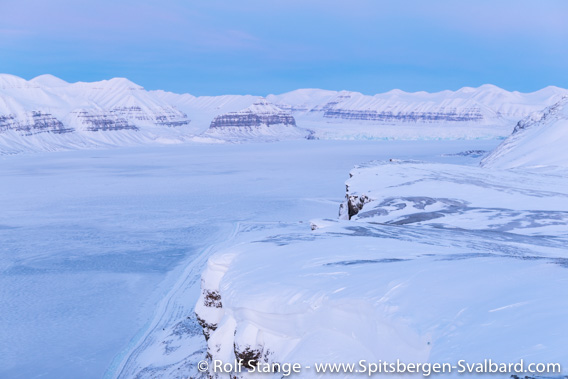
View from Fjordnibba into Tempelfjord.
It is not just the air that is icy, so are the fjords as well. There is a continuous layer of ice stretching from Fredheim into Tempelfjord. Also Sassenfjord – the continuation of Tempelfjord towards Isfjord – shows clear signs of freezing. If this only continued! We will see what happens the next weeks.

Lukas enjoys the amazing views over Tempelfjord.
After enjoying the amazing views from the little mountain Fjordnibba, we make a little excursion to Fredheim, the famous hut built by the even more famous trapper Hilmar Nøis. He started building Fredheim in 1924 and turned it into a real home during the years to come. In 2015, Fredheim was moved a few metres higher up and away from the coast that was slowly appraching the historical huts due to coastal erosion.

Fredheim, the hut built by Hilmar Nøis, in its new location.
We enjoy the place, the great scenery, the cold, the ice, the light and last but not least some hot soup for a while before we start moving back home. The days are still short, but it is amazing how quickly the light is coming back.

Ice on the shore of Tempelfjord.
Sunshine and 20 degrees …
Mon
18 Feb
2019
… is not really what you expect in Spitsbergen in February.
But it is also not really a good description of what we currently have in Longyearbyen.
Theoretically, we should have had the first sunrise on Saturday (16 February). This does not mean that you can see the sun from Longyearbyen. You would have to climb one of the higher mountains such as Trollsteinen, something that is actually quite popular on that very day.
But it was cloudy, so a tour somewhere in the nearby valleys was a good thing.
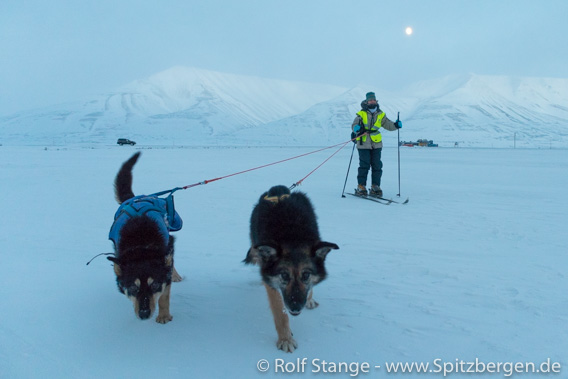
Moonlight tour with dogs in Adventdalen.
Today (Monday) was the first really clear day. The grey snow clouds gave way to the clear sky during the morning. The blue light of the late polar night is now giving way to the pink-blue light of the early polar day, at least around noon.
So today we could see the sun again – at least indirectly. It won’t be before 08 March that you can see the sun directly in Longyearbyen again, something that will be celebrated duly. But the mountains are now getting beautiful crowns of pink-orange glowing light now for a while around mid-day.
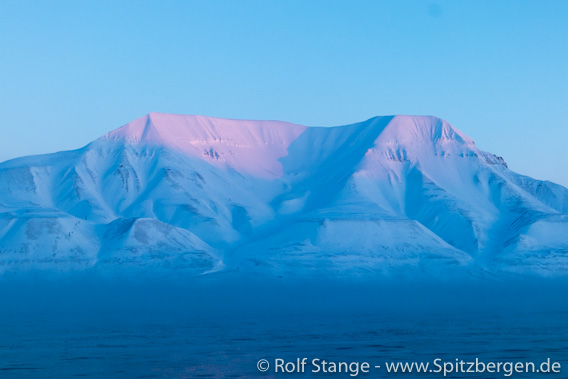
First sunlight on Hiorthfellet.
The sun remained above the horizon for quite some time, casting her beautiful light over the mountain tops for the first time in months, while the moon is climbing over the peaks.
Yes, and we do have 20 degrees (centigrade) and even more. Below zero, of course!
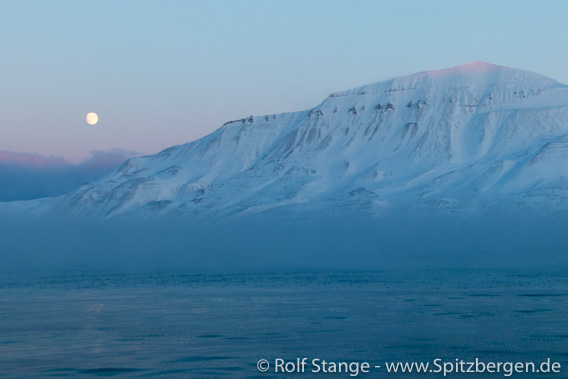
The moon next to Adventtoppen.
Lunckefjellet: the end of an arctic coal mine
The Lunckefjellet coal mine is a political-economical phenomenon. The first ton of coal was “produced” in November 2013 – a symbolic act, the mine was not yet in productive operation. This was not the case either when Lunckefjellet was officially opened on 25 February 2014, but the mine was “ready to go”. Many thought production would start now big-time, as the mine had until then cost more than 1 billion Norwegian crowns (more than 100 million Euro) and it was there and ready to start production.
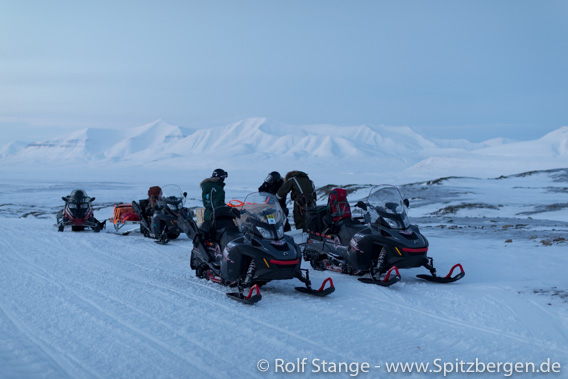
Scientists on the way to the Lunckefjellet coal mine.
But this was not to happen. The coal prices on the world markets dropped and the mines of Sveagruva, the Norwegian mining settlement in Van Mijenfjord, went into standby operation just to make sure they would not become inaccessible and mining could start one day – if this decisions was made.
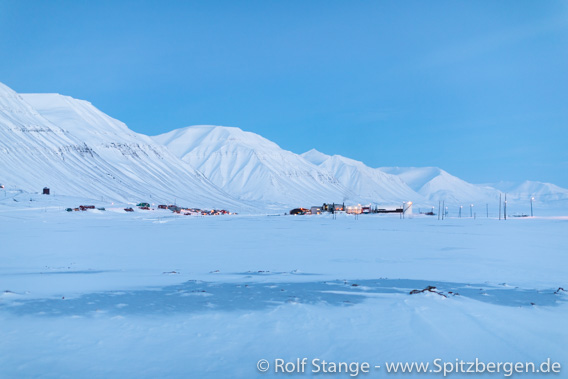
Sveagruva: Norwegian coal mining settlement (Swedish foundation in 1917) in Van Mijenfjord.
In the fall of 2017, the Norwegian government put their foot down. Being the 100 % owner of the Store Norske Spitsbergen Kulkompani (SNSK), the company that owns and runs all Norwegian coal mines in Spitsbergen, the government could directly decide about the fate of mining and miners in Sveagruva and Longyearbyen and related economies. The decision in 2017 was to put an end to all mining in Sveagruva. Both the coal mine Svea Nord, which had been profitable for a number of years, and the new mine in Lunckefjellet were to be phased out and physically cleaned up as far as possible. And the same was to happen for the settlement Sveagruva itself. Norwegian coal mining in Spitsbergen is only continued now in mine 7 near Longyearbyen (where the operation has since increase from one shift to two shifts).
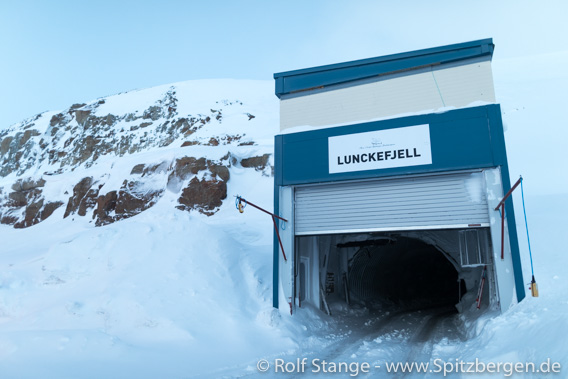
Day facilities and mine entrance at Lunckefjellet.
The reasons were officially said to be entirely economical considerations. The government does not really give more information than necessary, relevant documents have been declared confidential. Many see the end of coal mining in Sveagruva, especially in the newly built Lunckefjellet mine, with a tear in their eyes, as tradition, jobs and an industry that is important for Longyearbyen are about to get lost.
The end of coal mining in Spitsbergen does not come as a total surprise, everybody knew it would come one not too far day. Other branches are developed, with science, education and tourism high up on the list. Nevertheless, Longyearbyen would not exist without coal mining and mining has been the main activity here for most of the history so far. Many people have an emotional connection to mining and quite a few still have a real one, directly or indirectly, and losing coal mining will hurt them economically.
The government was not interested in discussing offers from investors to continue mining in Lunckefjellet, which was never intended to last for more than maybe 7-8 years anyway. This does not add to the credibility of the official reasoning for closing of the Lunckefjellet mine being solely based on the difficult economy.
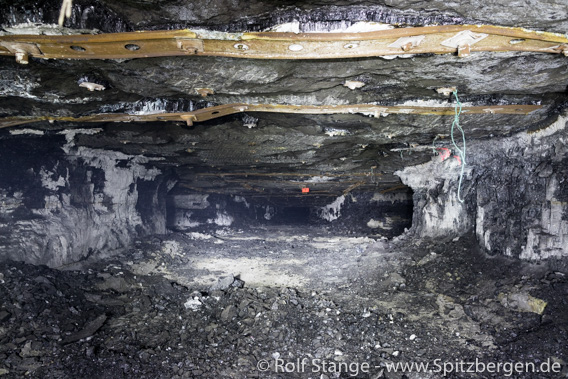
Tunnel of the coal mine in Lunckefjellet.
The coal mine in Lunckefjellet will be closed soon. The ventilation system is currently being dismantled, and once that is not operative anymore, only specialists with self-contained breathing apparatus could, theoretically, still enter the mine – for a short period, until the roof has become mechanically unstable. This will not take a lot of time. The Lunckefjellet mine will soon be as difficult to reach as the far side of the moon.
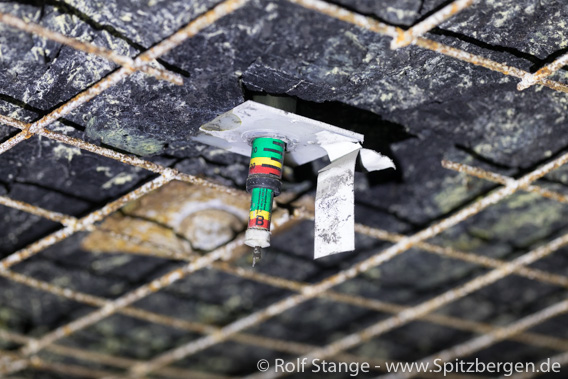
Device to monitor rock movements in the roof of the mine.

Bolts to secure the roof are exposed to permanent erosion and mechanical stress. If they are not regularly controlled and serviced a coal mine soon becomes a very dangerous place.
Last week (5-7 February 2019), geologists from the mining company Store Norske and UNIS took literally the last chance to take samples from the coal seam in Lunckefjellet. The coal geology in Spitsbergen is less well known than one might assume and than geologists would want it to by: nobody really knows what the landscape exactly looked like where the bogs grew that later formed the coal.
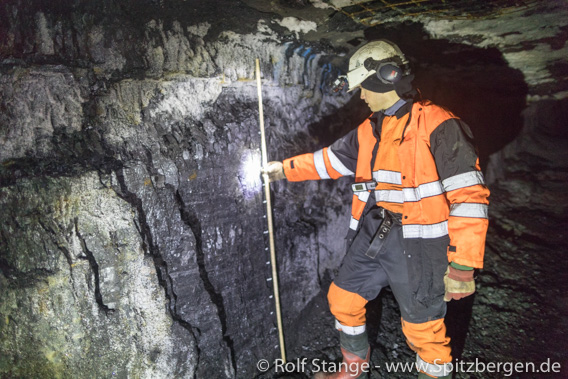
Geologist Malte Jochmann at work in Lunckefjellet.
Of course there were bogs, and saltwater from a nearby coast is likely to have been an important factor, at least at certain times. But which role did sweetwater play, lakes and rivers? Why are there sandstone and conglomerate (gravel-bearing sandstone) layers and channel fillings within and just on the edge of the coal seam? What did the sea level do at the nearby coast, what was the influence of tectonics? Were there hills or even mountains in the area, or was the surrounding relief more or less level?
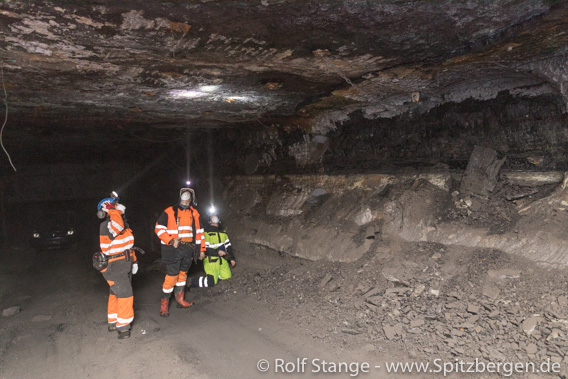
Geologists Malte Jochmann, Maria Jensen and Christopher Marshall at work in the Lunckefjellet mine, inspecting outcrops and potential sampling sites.
A walk through the tunnels of the Lunckefjellet mine produces fascinating views into the geological history, raising questions and answering some of them. The geologists Malte Jochmann (SNSK/UNIS), Maria Jensen (UNIS) and Christopher Marshall (University of Nottingham) had just two days to document outcrops and to take samples which might answer some of these questions in further, detailed investigations involving advanced laboratory methods.
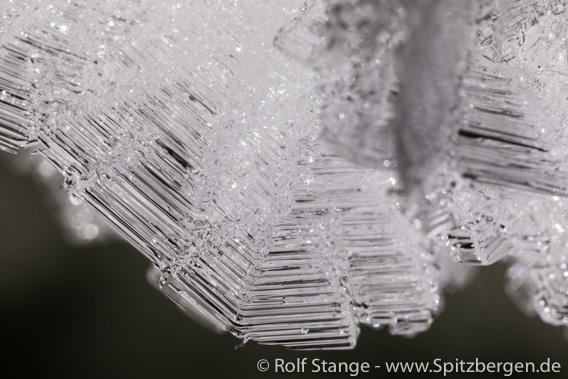
Even inside a mountain you are constantly reminded that you are in the Arctic: the temperature is constantly below zero, and ice crystals are growing on black coal surfaces.
Now the Lunckefjellet mine is about to be closed forever. A lot of equipment has already been removed, soon the mine can not be entered anymore. Also Sveagruva will be subject to a major clean-up, initial work has already begun. There won’t be much left in the end. Some artefacts which are considered having historical value will remain (everything older than 1946 is generally protected in Spitsbergen, the threshold will probably be moved up to 1949 in Sveagruva) and possibly a very few buildings for future use – research? Limited tourism? Nobody knows.
It will not be mining, that is for sure.
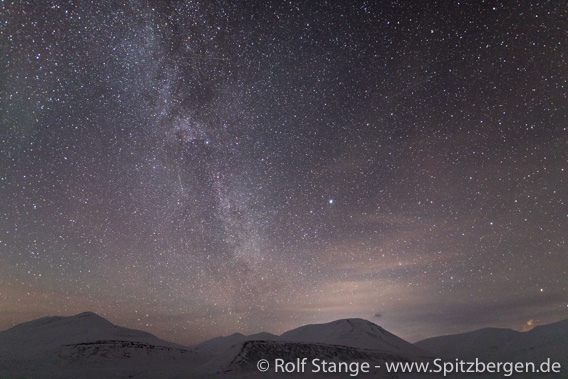
Sky of stars on the way back from Sveagruva to Longyearbyen.
A day in Spitsbergen: polar dogs and polar jazz
Sun
3 Feb
2019
The experiences to be made here in Spitsbergen in one day can be very rich in contrast: a little ski tour in Adventdalen with company on four legs brings exercise, fresh air and impressions of light and landscape – pure pleasure. For all involved, with two and for legs.

With ski and dogs Adventdalen.
A few hours later you may find yourself in an old hall which belongs to mine 3. No coal is mined in mine 3 anymore, after years of silence it is now regularly used as a mining museum and occasionally for events. Today, there is one of the last concerts of this year’s Polarjazz festival going on here. An experimental Spitsbergen-Jazz-opera – does that make sense? 🙂 The title is “Spor” (tracks) and it combines stories, impressions and emotions from the history and nature, hunting and mining in Spitsbergen. All of that is put into music and sounds by a trio, in major parts with the additional voal powers of the Store Norske Mannskor, resulting in sounds that vary from spheric/experimental through jazzy to groovy.
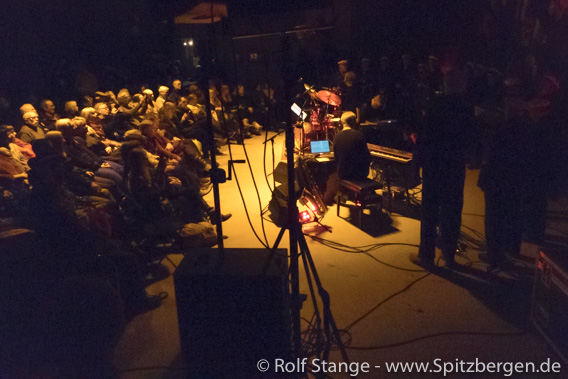
Polarjazz 2019: ‘Spor’ in Mine 3.
The atmosphere of the event was certainly even increased by the location.
Northern lights, northern lights, northern lights …
Sat
26 Jan
2019
My dear friends, let me tell you, it is tough. For weeks we have been trying to get some sleep at normal times. But it just doesn’t work. This northern light is really too bad. Really, it can be annoying! You always have to go out, watch Lady Aurora dancing, take photos … yes, life in the Arctic can be hard … 🙂

Northern light aureola, near-vertically above the photographer’s position.
It was almost warm today, just about -6°C in Adventdalen. In comparison to the last days, it felt really mild. Only the wind was a bit chilly.

Ring of northern lights over Endalen.
I can’t promise that there won’t be any more aurora borealis pics in this blog during the next weeks. This is how the polar night is. On the other hand, Lady Aurora can be very moody. Sometimes she is just sleeping somewhere far away or she is just dancing for the clouds. When she is in good mood then you just have have to take the opportunity. You never know when the next one comes – maybe this is her farewell for the moment and she decides to move on to another planet or wherever.
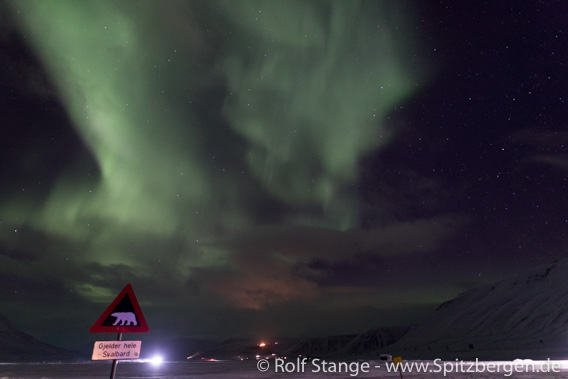
The famous polar bear warning sign.
Blue lights and northern lights
Fri
25 Jan
2019
The days are just flying, or rather this endless night. It will still take a while until you can talk of “days” again in Spitsbergen. But the light is coming back! There is clearly some faint dawn on the southern horizon around noon. The sun is not far anymore.
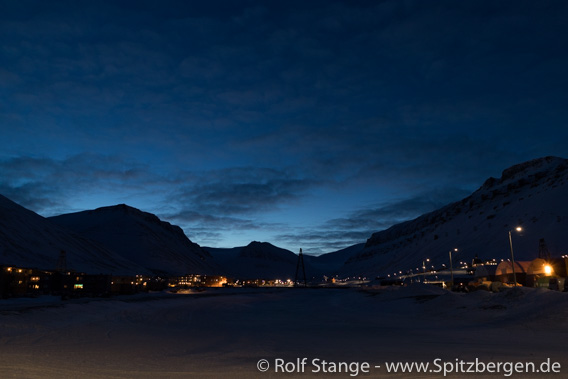
First dawning in late January, mid-day in Longyearbyen.
Still, the polar night is obviously a good time to do things inside. And there is no lack of good opportunities. Next to all the work that never takes an end, there is, just to give one example, the already mentioned Svalbarseminar. And for Per Kyrre Reymert, the “cultural heritage oracle”, the same is true as for Maarten Loonen (see previous blog): you are guaranteed to get a solid portion of interesting arctic knowledge, and it is fun to listen to! A very entertaining hour where you can only try to memorise as much as you possibly can. Today, it was about the French Recherche-expedition (1838, 1839). Yes, that was the one with Leonie D’Aunet, the first woman who visited Spitsbergen. As far as we know, that is.
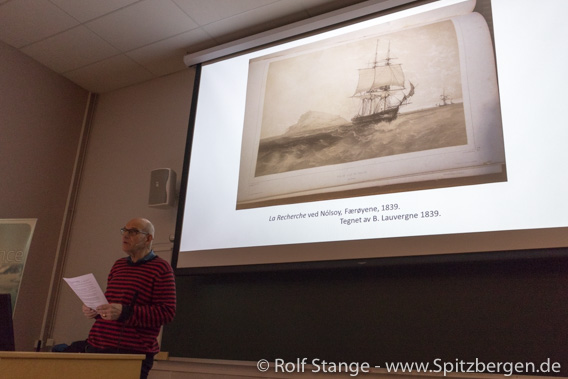
Per Kyrre Reymert speaking in the Svalbardseminar at UNIS about the Recherche-expedition (in Spitsbergen 1838 and 1839).
And it is certainly good to know what the guys from the Sysselmannen (government representative, police and other sovereign duties) are keeping themselves busy with. Flying drones, for example. Of course they are only doing sensible things with these drones! Who would thing of anything different … Police investigations, search and rescue operations, documenting erosion and wear and tear on cultural heritage sites … the list is long.

The “drone-squadron” of the Sysselmannen presenting their work in the Svalbardseminar at UNIS.
It is and remains stunningly beautiful outside. The light of the moon is now less bright than last week, but the returning sun – still well below the horizon – brings several hours of blue light into the darkness during daytime.
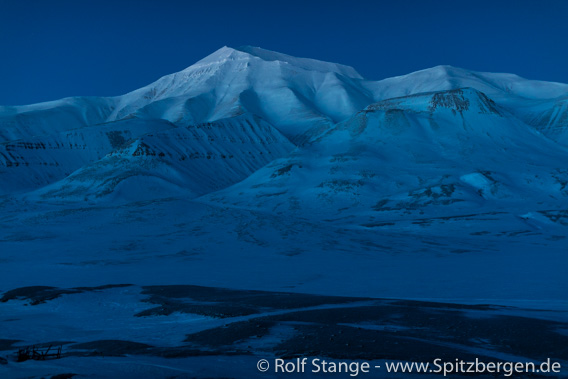
The blue light hours are coming back to Spitsbergen during daytime.
A little trip into Adventdalen, far enough to escape the “big city” light pollution. The silence and the blue light are amazing! And the view into Adventdalen wettens the appetite for more. That is the way to Sassendalen, to Tempelfjord, to the east coast, … soon will the days be longer and the same goes for the trips out into nature!
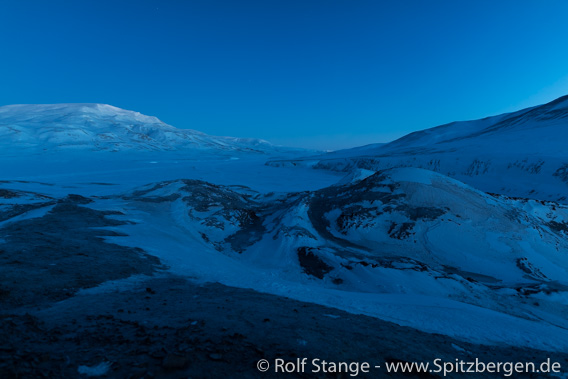
View into Adventdalen during the blue light hour(s).
Soon, however, the blue light gives way to darkness again, the “days” are still short. But the night does always have something to offer. In recent days, northern light activity was a bit limited. Not that there weren’t any at all, but limited, and sometimes you do also have to sleep, so it is inevitable to miss out sometimes. It is all about being in the right time at the right place, and that little bit of luck!
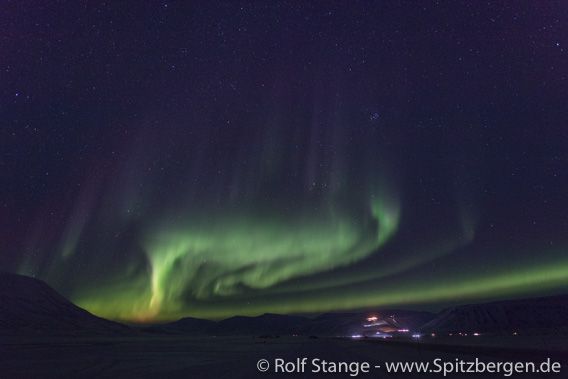
Northern light over Adventdalen (I).
The lights of mine 7 and some huts in the lower right corner.
Today, we were – once again – at the right time in the right place. We just had that bit of luck. Kind of on the way to go shopping. Never leave the house without the camera 🙂

Northern light over Adventdalen (II).
Lunar eclipse over Spitsbergen
Mon
21 Jan
2019
Today (21 January 2019) was the day (well, it is not really a day, the sun does not rise at all here currently) of a major astronomical event, the next one after the solar eclipse in 2015. The lunar eclipse that was visible in Spitsbergen from approximately 6 a.m. was certainly worth setting the alarm clock for.

Today’s lunar eclipse: the “blood moon” over Longyearbyen.
After a short observation of the initial lunar eclipse over Longyearbyen, we went out into Adventdalen to get further away from the big city lights and to get a natural background for the impressive celestial event.

Lunar eclipse over Adventdalen: the “blood mmoon” over Spitsbergen (I).
The duration of the lunar eclipse was much more agreeable than that of the above-mentioned solar eclipse, the total phase of which did not last longer than 2 minutes and a few seconds. This could make the astro-photographers sweat despite of the temperatures around minus 20 degrees (C) back then.
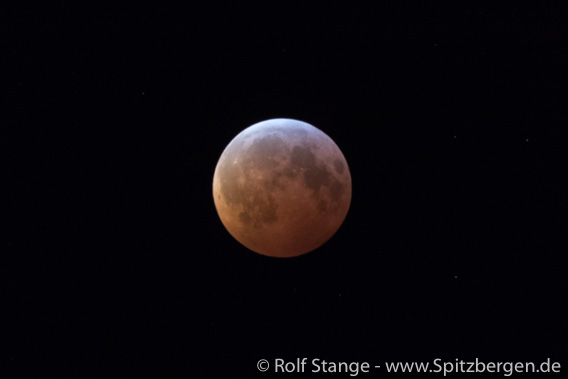
Mondfinsternis im Adventdalen: der “Blutmond” über Spitzbergen (II).
Not that it was any warmer today, but we could take it with time: the total phase of today’s lunar eclipse was nearly an hour long, so next to taking photos, we could just enjoy the event and a sip of hot chocolate – a very good thing considering the temperature. The stars were amazing, they came out bright and strong due to the reduced moonlight. Very impressive!
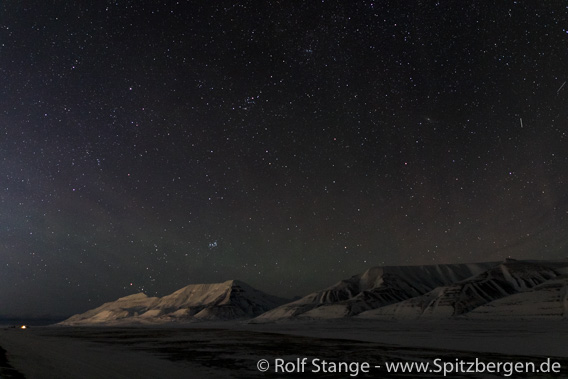
Stars during the lunar eclipse in Adventdalen.
Finally, my current ceterum censeo: I have made a new photo book, focussing on aerial photography and thus showing the Arctic from a very unsual perspective. In theory, the book is in German, but in practice, it does hardly have text. 134 out of 137 pages do just have stunning photos, placenames and a little map. Norwegens arktischer Norden (2) – Aerial Arctic shows Jan Mayen and Svalbard from the air.

Rolf’s new photo book Norwegens arktischer Norden (2) – Aerial Arctic shows Jan Mayen and Spitsbergen from a new and stunning perspective.
News-Listing live generated at 2025/May/02 at 17:33:11 Uhr (GMT+1)
